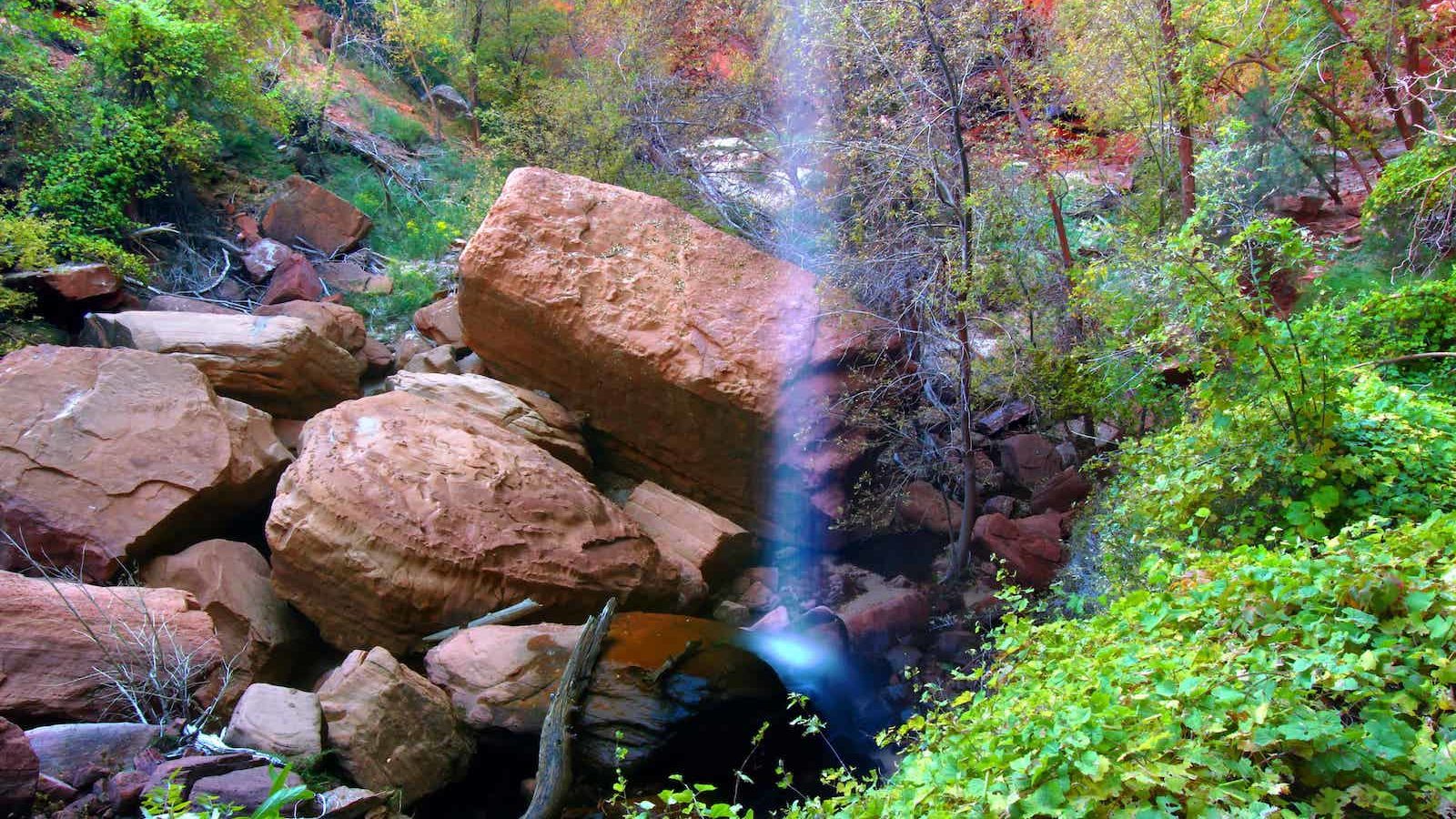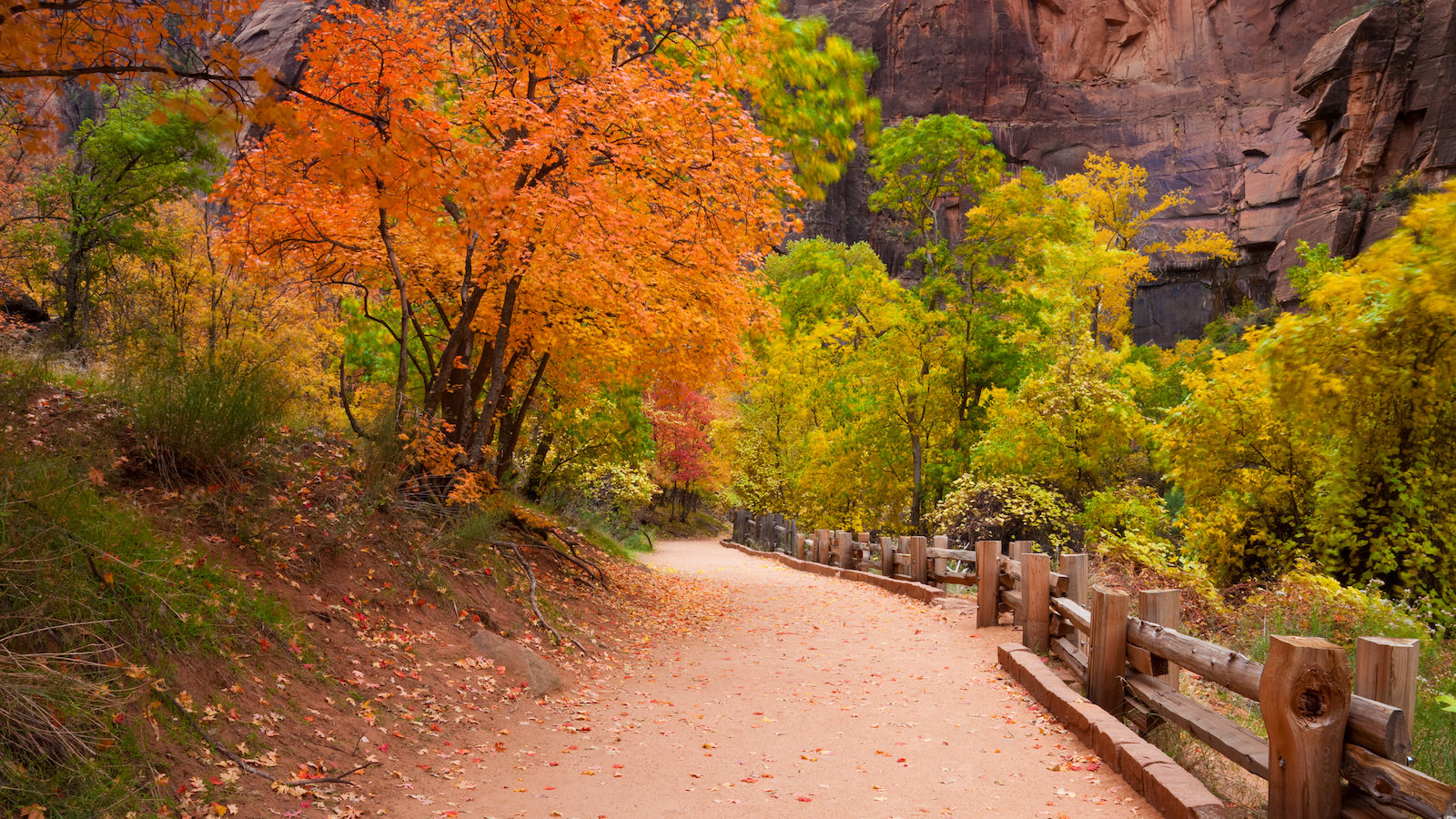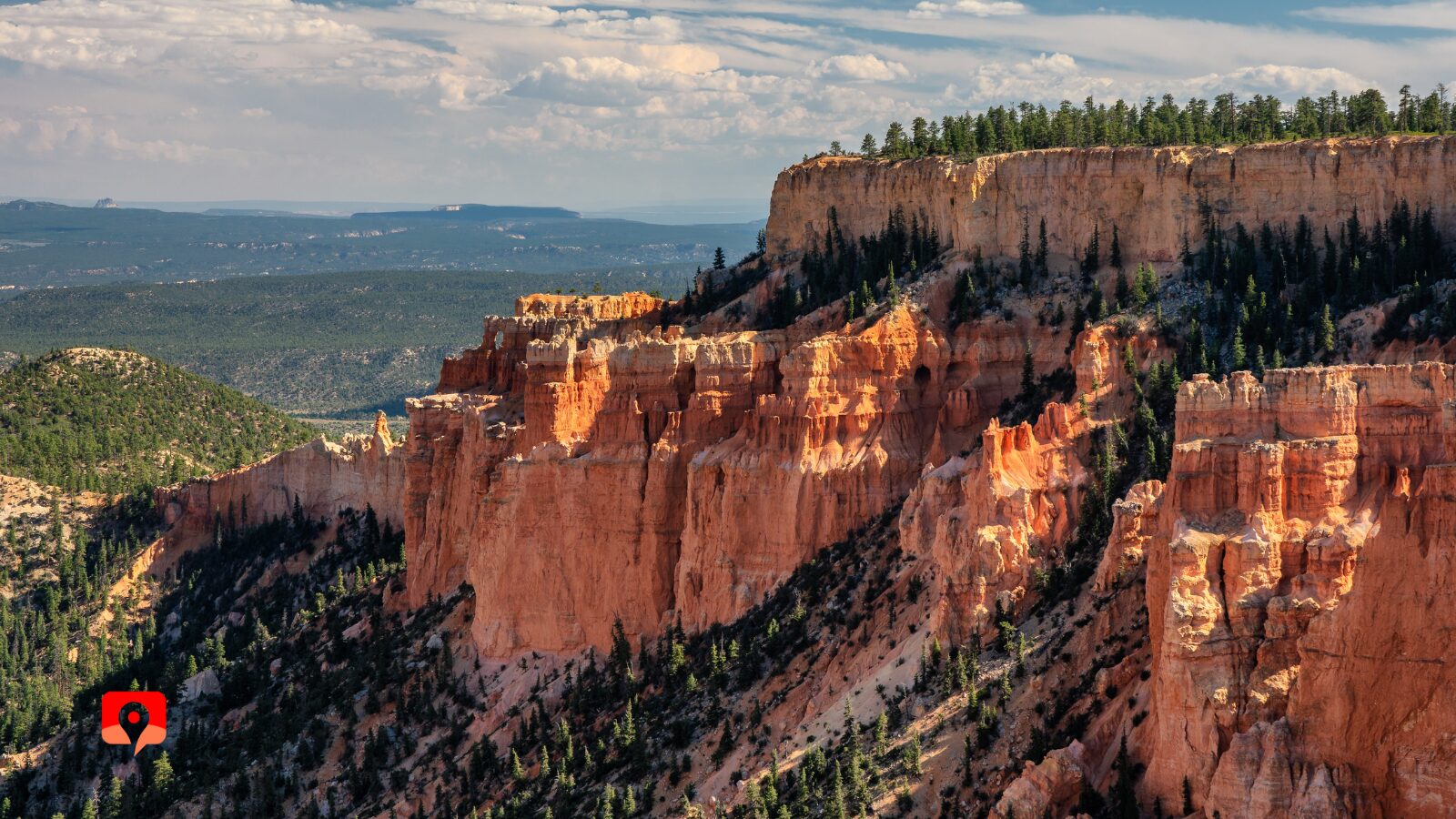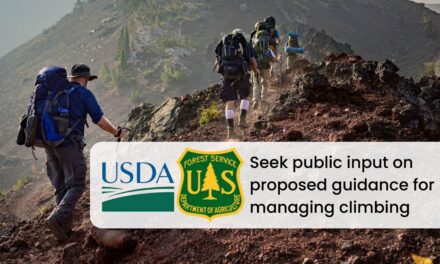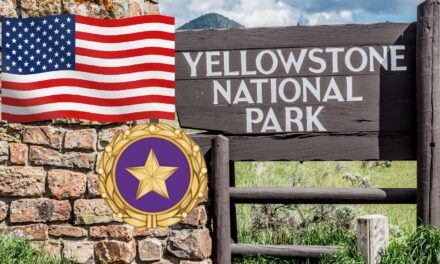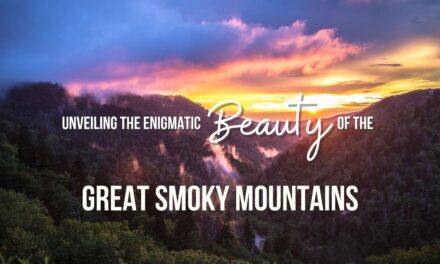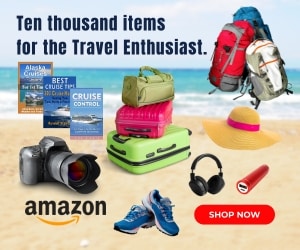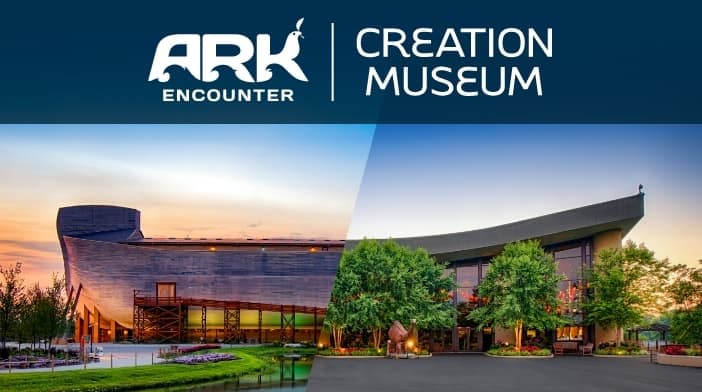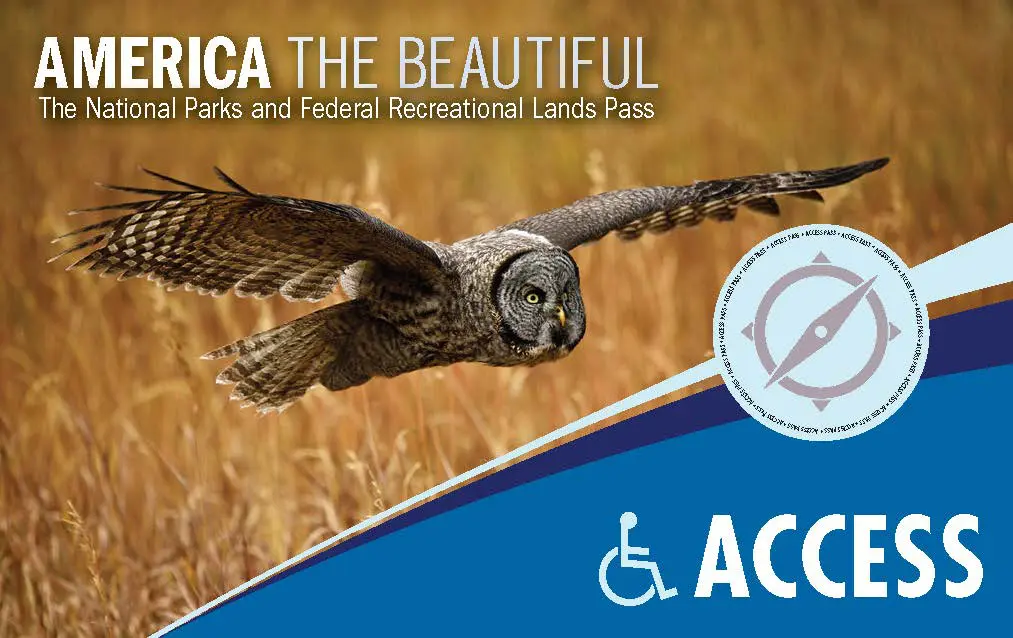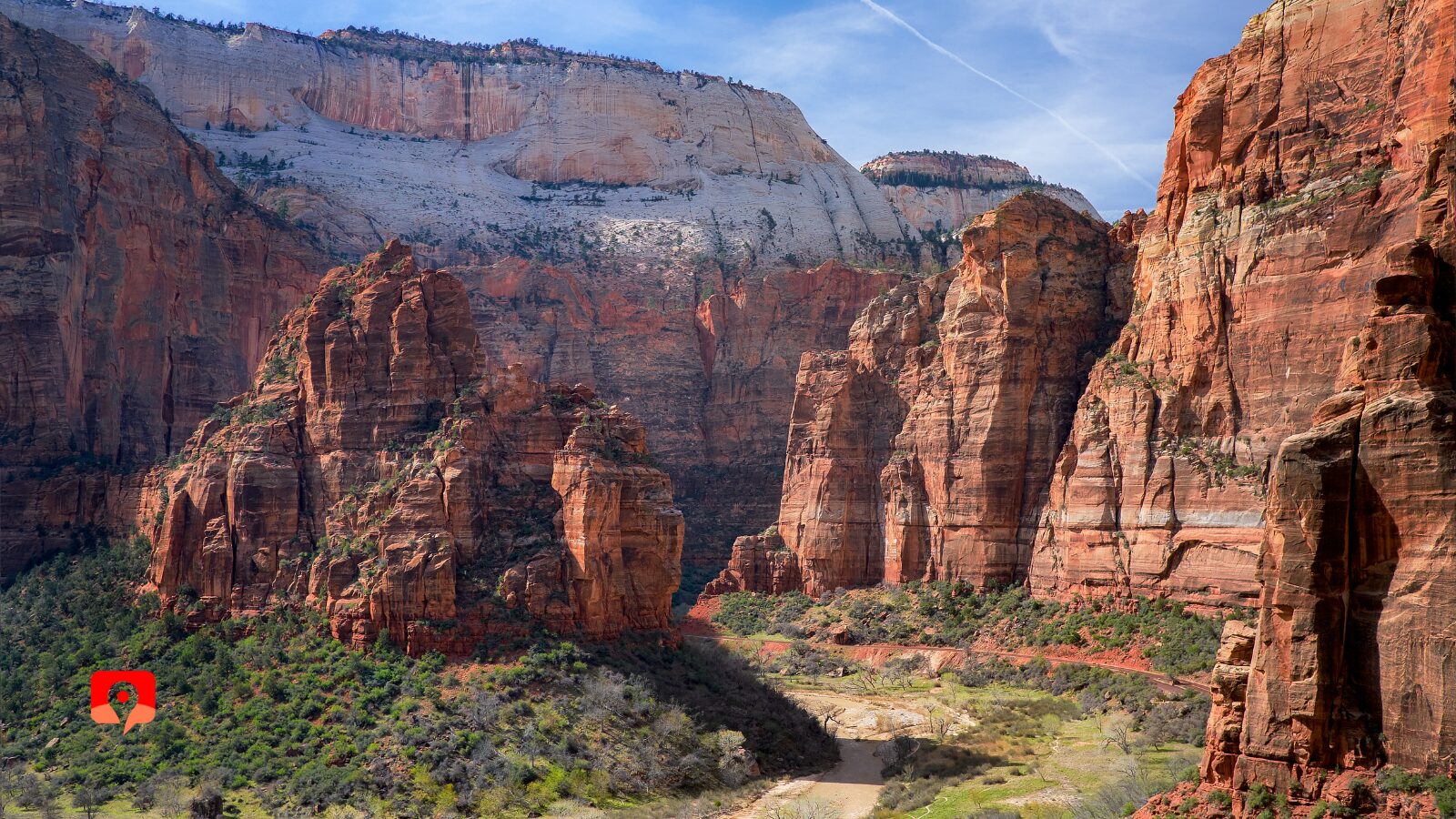
Zion & Bryce Canyon National Parks Trip Planner
Zion and Bryce Canyon are two of America’s most popular national parks. Both feature spectacular red rock scenery but each has its own unique geology and vastly different vegetation. Less than a 90-minute drive separates the two parks and they can be easily visited on the same trip.
Zion National Park is one of America’s most diverse national parks. Its elevation varies from 3,700 feet (1,128 meters) to 9,000 feet (2,743 meters) and it is home to a vast array of towering canyons, forested mountains, and lush riverside scenery. Most visitors focus their efforts along the 6-mile Zion Canyon Scenic Drive, so visitors looking to escape the crowds will find plenty of untouched splendor here.
Bryce Canyon, on the other hand, is an otherworldly land of colorfully striped rock spires called hoodoos, natural bridges, and other fascinating rock formations. It’s not a canyon at all, rather it’s a collection of over a dozen natural amphitheaters carved by erosion on the eastern side of the Paunsaugunt Plateau.
Contents
How to Get Here
Getting Around & Shuttles
Entrance Fees
Where to Stay
Map
When to Visit
How to Avoid the Crowds
What to See and Do
Best Sunset Spots
How Long Do You Need To Visit
Best Hikes
Awesome Experiences
Packing List
Top Travel Tips
How To Get Here
Zion and Bryce Canyon national parks are located in southwestern Utah. Most visitors fly into Las Vegas, Nevada, or Salt Lake City, Utah, although some visitors may fly directly into St. George, Utah, or arrive by car. Many people visit Zion and Bryce Canyon on the way to Grand Canyon National Park as part of a bucket list national parks tour.
By Plane
St. George – SGU
The St. George Regional Airport is the closest airport to Zion and Bryce Canyon. It’s only 45 miles (72 kilometers) from the airport to the main entrance of Zion National Park. Limited commercial flights are available but daily connections are available from Denver, Colorado, Salt Lake City, Utah, and Phoenix, Arizona.
Las Vegas – LAS
McCarran International Airport in Las Vegas is the closest major airport to Zion and Bryce Canyon. Las Vegas is 166 miles (267 kilometers) to Zion National Park and 250 miles (402 kilometers) to Bryce Canyon National Park. Las Vegas is a great option if you’re also planning on visiting Grand Canyon National Park.
Salt Lake City – SLC
The Salt Lake City International Airport is 237 miles (381 kilometers) north of Zion National Park and 273 miles (439 kilometers) north of Bryce Canyon National Park. Flying into Salt Lake City may be the more convenient option if you’re also planning to visit the other Utah national parks.
By Car
Most visitors arrive at Zion and Bryce Canyon National Park by car. Alternatively, the St. George Shuttle provides transportation between both Las Vegas and Salt Lake City to Springdale, Utah, the gateway to Zion Canyon. A car is required to get to Bryce Canyon National Park.
Getting Around
For most of the year, Zion National Park requires all visitors to use the Zion Shuttle System to minimize congestion in the Zion Canyon section of the park. There is no shuttle system along the Zion-Mount Carmel Highway, the Kolob Canyons section of the park, or along the 18 mile scenic drive in Bryce Canyon, past Bryce Point, and you’re free to drive yourself.
Bryce Canyon offers a shuttle system between Bryce Canyon City, the Visitor Center and as far as Bryce Point, but usage is optional.

Zion Canyon Shuttle
The Zion Canyon Scenic Drive is closed to private vehicles whenever the shuttle is operating, which is typically from March to November as well as weekends in December and February. All visitors are required to take the shuttle bus into the park and should park at the Zion Canyon Visitor Center or in designated parking areas in the town of Springdale.
The first shuttle leaves the visitor center at 6:00 am and stops at numerous viewpoints and trailheads in the park. Shuttles depart every 6-10 minutes at each stop and the last shuttle leaves the Temple of Sinawava at 8:15 pm. Shuttles are included in the cost of your park pass, and operate on a first-come, first-serve basis.
Bryce Canyon Shuttle
The Bryce Canyon Shuttle is voluntary unless you’re traveling in a vehicle measuring 20 feet (6 meters) or longer, which are prohibited from parking at the visitor center, Sunrise Point, Sunset Point, Inspiration Point, Bryce Point, and Paria View while the shuttle is operating. Shuttle season typically runs from mid-April to mid-October and buses from 8 am to 8 pm with shorter hours in April and October.
Visitors can hop on the shuttle in Bryce Canyon City, the visitor center, campgrounds, and several park viewpoints and shuttles run every 15 minutes. Shuttles are included in the cost of your park pass, and operate on a first-come, first-serve basis.
And remember, parking restrictions apply during shuttle hours to vehicles that are 20 feet (6 meters) or longer at the Visitor Center 1-hour Parking Lot, Sunrise Point, Bryce Lodge, Sunset Point, Inspiration Point and Bryce Point as well as Paria View at all times due to the parking lot size.
Entrance Fees
All park visitors are required to purchase a recreation pass upon entering Zion and Bryce Canyon national parks. Passes are valid for seven consecutive days and available for purchase at entrance stations and visitor centers. Weekly passes are only good at the park purchased, meaning you must purchase a separate pass for Zion and Bryce Canyon. Discounted passes are available for veterans, seniors, and families of 4th graders.
If you plan to visit both Zion and Bryce Canyon national parks on the same trip, consider purchasing the America the Beautiful – The National Parks and Federal Recreational Lands Annual Pass. The pass provides entrance to both Zion and Bryce Canyon national parks as well as all other national parks and federal recreation areas for nearly the cost as individual passes to Zion and Bryce Canyon.
Zion & Bryce Canyon National Parks Map
Where to Stay
Zion National Park
Zion National Park has three campgrounds – South and Watchman campgrounds in Zion Canyon and Lava Point Campground in Kolob Canyon and motel rooms and cabins available at the Zion Lodge.
Lodging in Zion is extremely popular so secure a reservation far in advance if you can.

Watchman Campground reservations are available six months in advance and reservations for the South Campground only open two weeks in advance. A handful of first-come, first-served sites are available but they often fill early in the morning. Most campsites have very little shade so be sure to come prepared for high daytime temperatures when camping in summer.
Outside Zion National Park
Dozens of hotels and resorts line the city streets of Springdale, right outside the south entrance of the park. Additional lodging is also available in Rockville, Mt. Carmel Junction, Hurricane, and St. George. There are also several private campgrounds and RV parks just outside the park.

Bryce Canyon National Park
The Lodge at Bryce Canyon offers rustic cabins, newly-renovated hotel rooms, and guest suites. Bryce Canyon also has two campgrounds, North and Sunset, each located near the visitor center. The North Campground is open year-round, and reservations are required during peak summer season. The Sunset Campground is open from April to October on a first-come, first-serve basis.
Outside Bryce Canyon National Park
Ruby’s Inn RV Park and Campground is a popular place to stay just outside the park. Ruby’s offers hotel rooms, cabins and tipi rentals, tent sites, and RV sites with full hook-ups and all guests can enjoy free shuttle service into the park from Ruby’s with park admission. Additional lodging is found in the nearby towns of Bryce Canyon City, Panguitch, and Cannonville. You’ll also find additional campgrounds in neighboring Red Canyon, Kodachrome Basin State Park, and Grand Staircase-Escalante National Monument.
Like having a tour guide in your car™
DISCOVER MORE ZION & BRYCE CANYON

Listen to stories, local tips & directions along the road. Commentary plays automatically based on your location. No cell or wifi required, tour offline with GPS.
Audio Player
00:00
00:00
Use Up/Down Arrow keys to increase or decrease volume.
Audio Player
00:00
00:00
Use Up/Down Arrow keys to increase or decrease volume.
Audio Player
00:00
00:00
Use Up/Down Arrow keys to increase or decrease volume.
When To Visit
Both Zion and Bryce Canyon national parks are open year-round but a majority of visitors come between April and September. June and July are the busiest months and parking lots in Zion often fill to capacity during this time. Bryce Canyon sees fewer visitors than Zion but parking areas still fill near popular trailheads all summer long.

Zion sees very hot temperatures in summer whereas Bryce Canyon tends to be much cooler in summer thanks to its higher elevation. That being said, nights in Bryce Canyon can still be pretty chilly even in late Spring.
The best time to visit Zion and Bryce Canyon will depend on what you most want to see and do. The Zion Narrows is best hiked during the summer months but the popular Angels Landing Trail sees extreme heat and frequent thunderstorms in July and August. Trails may temporarily close in winter due to snow and ice.

How Much Time Do You Need to Visit Zion and Bryce Canyon National Parks
Ideally, you need two to three days to really explore Zion National Park. This will give you enough time to hike one of the longer trails such as Angels Landing or the Narrows and enjoy all the major viewpoints.
If you only have one day, you’ll still have plenty of time to see many of the major roadside views along Zion Canyon and squeeze in both the Lower Emerald Pools hike and the Riverside Walk.
Bryce Canyon National Park is one of the most compact, easy to see in a day national parks in the country but that’s not to say it’s not deserving of more time. If you only have one day or even just half a day, you can see a lot in a short amount of time.
Start at the visitor center for a short lesson on how hoodoos form and then drive the park road stopping at various viewpoints along the way. If you have more time, venture below the rim and explore the network of trails that weave in and around the canyon’s hoodoos and interesting rock sculptures.

How to Avoid the Crowds
If you have some flexibility, visit just outside the peak season in March and October. If you must visit during the busy summer season, avoid Memorial Day weekend, Fourth of July weekend, and Labor Day weekend if you can. The third week of October, when most Utah schools take their fall break, also tends to be a very busy time to visit the parks.
To avoid the summertime crowds in Zion, get to the park early in the morning to ensure a parking spot, hike popular trails first thing in the morning or later in the evening, head to lesser-visited sections of the park such as Kolob Canyon, and use your bike rather than deal with the lines at the shuttle bus stops.
Although Bryce Canyon does not get as crowded as Zion, the park still sees its fair share of visitors. To get away from the crowds, start your day early and drive the scenic drive. Exit the Park, and then return using shuttles to access the popular viewpoints or head out on one of the longer trails such as the Fairyland Loop or Peekaboo Loop.
What to See and Do in Zion National Park

Court of the Patriarchs
One of the most famous landmarks in the park, the Court of the Patriarchs is three prominent sandstone peaks named after the biblical figures of Abraham, Isaac, and Jacob. The peaks tower above the west side of Zion Canyon and an excellent viewpoint is reached with a quick walk from the Court of the Patriarchs shuttle stop. Hike the Sand Bench Trail for a closer look at the peaks.
Temple of Sinawava
The Temple of Sinawava is a massive natural amphitheater that marks the beginning of Zion Canyon. The temple is located at the last shuttle stop along Zion Canyon Scenic Drive and the popular Riverside Walk begins here.

Zion-Mount Carmel Tunnel
When it was completed in 1930 to provide access to Grand Canyon and Bryce Canyon from Zion, the Zion-Mount Carmel Tunnel was the longest of its kind. It was an incredible engineering marvel at the time and is still a fantastic sight to behold. This 1.1-mile (1.8-kilometer) tunnel was constructed with huge windows to provide travelers framed views of Zion Canyon’s remarkable beauty. Unfortunately, there is no stopping allowed in the canyon today but you can still catch a glimpse out the windows while you drive through the tunnel today.
Checkerboard Mesa
With an unusual pattern of crosshatched cracks, Checkerboard Mesa is one of the most interesting geological formations on the eastern end of the park. There are several pull-outs along the highway where you can stop and snap some photos. For those looking to explore the Checkerboard Mesa up close, a 2-mile (3.2-kilometer) roundtrip hike leaves from the Checkerboard Mesa viewpoint parking area and travels to the mesa’s summit.
What to See and Do in Bryce Canyon National Park
Bryce Canyon Scenic Drive
The 18-mile (29-kilometer) park road follows the rim of Bryce Canyon and offers easy access to numerous viewpoints overlooking the wonderland of colorful hoodoos down below. The Rim Trail connects many of the viewpoints and numerous trails descend from the rim and weave through the impressive rock formations in the park.
Sunrise and Sunset Points
Sunrise and Sunset Points are located right near the visitors center and are connected to each other via a 0.5-mile (0.8-mile) paved section of the Rim Trail. Both lookouts offer fantastic views of the main Bryce Amphitheater and the popular Queen’s Garden Trail begins at the south side of Sunrise Point.

Inspiration Point
Inspiration Point is arguably the most spectacular viewpoint in Bryce Canyon. From here, visitors can look out across the entire Bryce Amphitheater and see thousands of hoodoos rising above a vast area called the Silent City. Although no trails lead down into the canyon from this viewpoint, the Rim Trail passes through here extending south to Bryce Point and north to Sunset Point.
Yovimpa Point and Rainbow Point
Located at the end of the Bryce Canyon Scenic Drive, these adjacent overlooks are the highest points in the park and provide some of the most sweeping views in the park. Rainbow Point looks northward into the Bryce Canyon amphitheater and offers one of the best views of the different sequence of rock layers in the distant Grand Staircase-Escalante National Monument. Yovimpa Point looks south towards the northern rim of the Grand Canyon.
Best Hikes

Angels Landing Trail – Zion National Park
If you only have time for one trail in Zion (and you’re comfortable with heights), the Angels Landing Trail is not to be missed. This strenuous 5.4-mile (8.7-kilometer) round-trip trail climbs 1,488 feet (453 meters) to a stunning viewpoint high above Zion Canyon. It’s the most popular hike in the park and the final section of the trail involves navigating a narrow, knife-edge ridge with the help of chains for safety.
HIKING PERMITS REQUIRED
As of April 2022, all Angels Landing hikers require a permit through a seasonal or day-before lottery system. Learn more about this new permit system on the National Park Service website and apply for your permit on recreation.gov.
Emerald Pools Trail – Zion National Park
The Emerald Pools Trail leads to a cluster of blue-green pools and waterfalls. A paved trail leads to the Lower Emerald Pool and several waterfalls. From here, a steeper and rockier trail leads to the Middle and Upper Emerald pools. The hike can be as short as 1.2 miles (1.9 kilometers) round-trip or 3 miles (4.8 kilometers) round-trip if you visit all three pools.
Riverside Walk – Zion National Park
The paved Riverside Walk follows the Virgin River for one mile (1.6 kilometers) upstream along the bottom of a narrow canyon to the entrance of the Zion Canyon Narrows. The trail is accessible to wheelchairs but some assistance is required to help navigate a few steep slopes. The pavement ends at the Narrows itself, a narrow gorge with sandstone walls over 2,000 feet (610 meters) high in spots.

The Narrows – Zion National Park
Doing the full Narrows hike is 16 miles (26 kilometers) one-way with a shuttle pick-up but casual hikers can still experience some of the best of the Zion Narrows by venturing into the Narrows from the end of the Riverside Walk. There’s no official trail, rather, the route involves walking and wading along the Virgin River. Hike as far as you want and then return the way you came. Travel can be slippery and always check the weather and flash flood reports before hiking into the Narrows.
Rim Trail – Bryce Canyon National Park
The Bryce Canyon Rim Trail hugs the rim and connects all the scenic overlooks from Fairyland Point to Bryce Point. The entire trail is 5.5 miles (9.16 kilometers) one way. The Rim Trail is a great option for an early morning or late evening walk and the views are spectacular every step of the way.
Queen’s Garden Trail – Bryce Canyon National Park
The Queen’s Garden Trail is the least difficult trail that descends below the canyon rim. The trail drops 357 feet (109 meters) and is a great way to see many of the magnificent hoodoos up close including Gulliver’s Castle, the Queen’s Castle, and Queen Elizabeth herself. Many hikers combine this trail with the Navajo Loop Trail and visit other popular rock formations such as Thor’s Hammer and Twin Bridges.
Mossy Cave Trail – Bryce Canyon National Park
Although this trail is often overlooked by visitors, it makes a nice little jaunt into the red rock pinnacles of Bryce Canyon with very little effort. The trail is 0.4 miles (0.6 km) one-way and ends at a picturesque little cave filled with moss in the summer and icicles in the winter. The hike begins from Highway 12 outside the main section of the park and is a great stopping point if you’re headed east of the park to Grand Staircase-Escalante National Monument or Capitol Reef National Park.
Awesome Experiences in Zion & Bryce Canyon National Parks
Bike the Pa’rus Trail – Zion National Park
Cycling is allowed on all park roadways and the paved Pa’rus Trail in Zion National Park. The Pa’rus Trail begins at the Zion Canyon Visitor Center and follows the Virgin River to Canyon Junction. The trail is great for families and is one of the only trails in the park that allows dogs.
Cross-Country Ski or Snowshoe in Winter – Bryce Canyon National Park
The contrast of stark white snow on a backdrop of red rock hoodoos makes Bryce Canyon even more stunning in winter. At 8,000 feet (2,438 meters) it snows often enough to allow for cross-country skiing and snowshoeing along the rim. You’ll also find a network of groomed ski trails just outside the park, and cross-country ski and snowshoe rentals at Ruby’s Inn.
Take a Guided Horseback Ride Through the Hoodoos – Bryce Canyon National Park
Horseback riding is a great way to enjoy a different perspective of Bryce Canyon. Horses were regularly used in the canyon before the area was set aside as a national park and several horse trails are still in use today. Guided horse and mule rides typically run from April through October and descend into the Bryce Amphitheater via a dedicated horse trail.
Attend a Night Sky Program – Bryce Canyon National Park
Return back into the Park at night and join rangers with the National Park Service as they use lasers and telescopes to point out the constellations in the night sky. Bryce Canyon National Park is certified with international dark sky status, with clear clean skies and thousands of stars visible including the Milky Way. Visit Bryce Canyon during the annual astronomy festival in June for four days and nights of geology and constellation talks and activities.
Best Places to Enjoy the Sunset
Canyon Junction Bridge – Zion National Park
Nothing compares to watching the Watchman glow with the setting sun from the Canyon Junction Bridge. To get there, get off on shuttle stop #3 or take the Pa’rus Trail from the main parking area. It’s the most popular sunset spot in the park so be sure to arrive with plenty of time before sunset to secure your spot on the bridge.
Canyon Overlook – Zion National Park
Located on the eastern end of the Zion-Mount Carmel Tunnel, the Canyon Overlook is one of the best overlooks in the park and it’s especially wonderful at sunset. The overlook is 0.5 miles (0.8 kilometers) from the parking area and you’ll want to pack a headlamp for the return trip back to your car.
Sunset Point – Bryce Canyon National Park
The aptly-named Sunset Point is one of the best spots for the sunset in Bryce Canyon. Better yet, head to Sunrise Point (or really anywhere along the Rim Trail) for an equally great view without the crowds that flock to Sunset Point in the evening hours.
Paria View – Bryce Canyon National Park
Some may argue that the sunsets pale in comparison to the sunrises in Bryce Canyon since most of the canyon faces east. Paria View is the exception though since it’s one of the few places in the park you can view the hoodoos facing west

Zion & Bryce Canyon National Parks Packing List
Extra Layers: The southern Utah desert is known for its extremes. Temperatures can fluctuate widely between the day and night and higher elevations will be much cooler. It’s best to come prepared for scorching daytime temperatures and chilly nights, and always be prepared for rain, even though it is a desert.
Sturdy Hiking Shoes: Comfortable walking shoes are a must even if you’re just sticking to the paved trails and viewpoints. Expect to spend a lot of time on your feet regardless of how much you plan to hike.
Water Shoes: If you plan to hike the Zion Narrows, having a pair of shoes you can comfortably wear in the water is essential. Specialized canyoneering shoes aren’t really necessary, a good pair of hiking boots or running shoes you don’t mind getting wet will do. Avoid hiking sandals or anything with an open-toe.
Hiking Poles: With the elevation gains, maintaining a better posture will help with breathing. Poles also help lessen the impact on your knees on the declines. And if hiking the Narrows, they will help you balance on the uneven rocky trail.
Binoculars: You’ll want to look closer at the towering cliffs and spot condors which are returning to Zion.
Headlamp: Hikes can take longer than you might expect, so pack a headlamp in case you are still trekking back as light fades.
Hiking Daypack: Daypacks are a necessity on visits to Zion National Park. Look for packs that have plenty of pockets and loops to have everything you need such as sunscreen, water, snacks, and a camera readily available.
Sun Protection: Sun protection is a must in Zion and Bryce Canyon year-round. The park’s high elevation makes the sun even more intense. Consider a wide-brim hat or long-sleeve shirt with UPF for added sun protection.
Refillable Water Bottles or Hydration System: Hydration is super important in southern Utah’s dry, desert climate. You’ll definitely want a good reusable water bottle or hydration bladder for your trip. Drinking water is available at multiple places in Zion Canyon and at various refill stations in Bryce Canyon National Park.
Plastic Bag: We always like to take along a plastic bag to pick up any trash we find along the trails or boardwalks. #leaveitbetterthanyoufoundit

Top Tips for Visiting Zion & Bryce Canyon National Parks
Visit Early in the Morning to Avoid Entrance Lines: Both Zion and Bryce Canyon national parks are incredibly popular places to visit. Avoid long lines at entrance gates, shuttle stops, and visitor centers by arriving at the park right when it opens.
Come Prepared: Bring everything you may need access to including extra layers, snacks, a refillable water bottle, and a camera.
Pack a DC charger & EarBuds: Stash a backup battery charger in your pack to daypack to ensure your phone/camera has enough charge to last throughout the day. And bring earbuds to continue listening to the tour while on the shuttles..
Check the Zion South Entrance Webcam: Check the traffic on Zion’s South Gate Entrance Webcam for current conditions. Also, consult the Zion National Park and Bryce Canyon National Park Twitter accounts for current information on any closures.
Check Current Trail and Weather Conditions: Trails such as the Zion Narrows and Angels Landing should not be attempted if rain is in the forecast. Keep an eye on the weather and pay close attention to trail closures.









